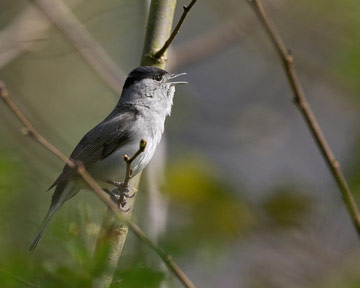
Blackcap © Richard Steel
A loud burst of song from a Blackcap deep in the undergrowth is usually the first sign that spring is really here. This is overwhelmingly the woodland Sylvia. Habitat codes submitted for this survey showed 48% in woodland, with 22% in scrub, 18% in farmland and 12% in human sites. Blackcaps mainly frequent mature deciduous or mixed woodlands – fewer than 1% of our habitat records are from coniferous woodland (A2) – with a well-developed shrub layer. They are found especially at the woodland edges, perhaps because greater light penetration makes for more luxuriant shrub growth there. When populations are high, as now, some birds spill out into farmland, where they occupy overgrown hedgerows, especially if they contain some tall trees. They also appear in urban areas, including areas of human habitation and industrial sites, anywhere where there is enough scrubby undergrowth, especially Bramble. Blackcaps were almost twice as likely to be recorded in human sites as any other Sylvia warbler.
The ‘change’ map shows that in the last twenty years Blackcaps have spread to become almost ubiquitous. They have increased along the Mersey Valley and spread into the eastern hills and onto the least well-wooded farmland in the south and south-west of Cheshire. They are now missing only from the very edges of the county – the highest hills, north Wirral coast, and the Dee and Mersey saltmarshes.
Although the early songs of Blackcap are unmistakeable, once Garden Warblers arrive, usually at least two weeks later, distinguishing the two species can be difficult. They do respond to each others’ songs, with Blackcaps dominating Garden Warblers and trying to keep them out of their territories; but this might just be a reaction against any intruder as they also react against Chiffchaffs entering their area.
As well as singing, the male Blackcap quickly builds a number of flimsy ‘cocks’ nests’, showing them to any arriving female until one decides to stay, choosing one of his nests and lining it. They have a short incubation period of around 13 days, with males taking an almost equal share during daylight hours, and chicks leave the nest after about 11 days, before they can fly properly, and crawl around the undergrowth. The sharp ‘tac’ alarm calls of the parents often alert observers to their best chance of proving breeding, FY accounting for 60% and RF a further 27% of the confirmed breeding records. Caterpillars and craneflies (tipulids) make up much of the chicks’ diet, with beetles especially for late broods when the former have declined in abundance.
Blackcaps have changed their breeding schedule remarkably, and were laying 15 days earlier in 2004 than twenty years previously. This could be a response to climate change: with a relatively short migratory journey to return to breed here, they are well placed to react to rising temperatures. British breeding birds spend the winter around the Mediterranean, with variable numbers from year to year crossing the Sahara. They used only to have one brood, with second attempts uncommon, but now some Blackcaps have more time to fit them in, giving them the chance of increased productivity and also allowing fieldworkers more extended opportunities to record breeding behaviour.
In the first (1964) county bird report Blackcap was said to ‘breed in small numbers’, probably a reflection of the bias in reporting and in birdwatching, but an interesting observation nevertheless. The species has increased consistently in abundance since the late 1970s, although the causes remain unknown. In the twenty years between our Atlas periods (1984-2004) the national population index for Blackcap has risen by 75%. The BTO BBS analysis shows that the breeding population of Cheshire and Wirral in 2004-05 was 12,910 birds (8,570-17,260), corresponding to an average of about 36 birds per tetrad with confirmed or probable breeding, or 21 birds per tetrad in which the species was recorded. Territories can be as small as 0.2 ha, depending on the habitat quality, so there is plenty of room for more Blackcaps in the county.
Sponsored by Bernard Machin

